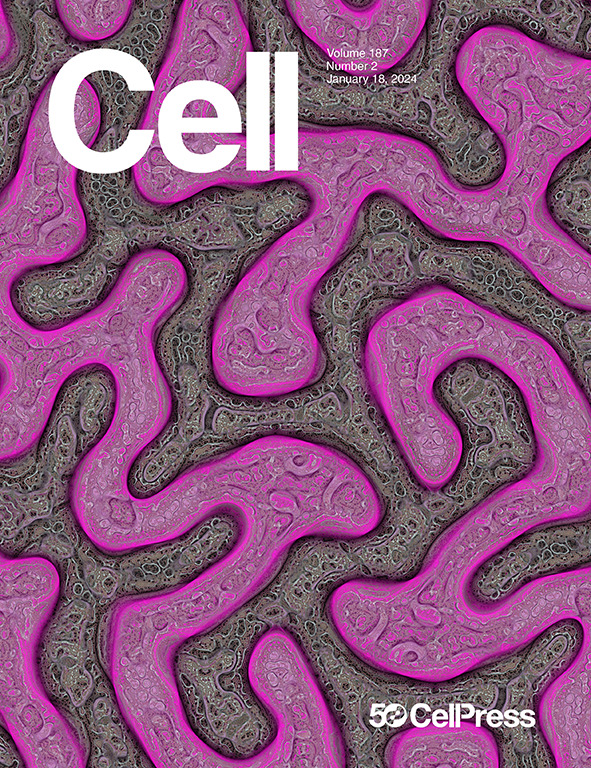ALDH7A1 通过生成膜 NADH 和调控 FSP1 防止铁变态反应
IF 45.5
1区 生物学
Q1 BIOCHEMISTRY & MOLECULAR BIOLOGY
引用次数: 0
摘要
铁下垂是一种由铁诱导的脂质过氧化引起的细胞死亡。铁凋亡抑制蛋白1 (FSP1)通过产生抗氧化剂来防止这种死亡,这需要烟酰胺腺嘌呤二核苷酸还原形式(NADH)作为辅助因子。我们最初发现NADH在细胞膜上存在显著水平,然后发现这种形式的NADH是由醛脱氢酶7A1 (ALDH7A1)产生的,以支持FSP1活性。ALDH7A1活性也通过消耗活性醛直接减少脂质过氧化。此外,ALDH7A1促进了FSP1的膜募集,这是由铁致应力激活amp活化蛋白激酶(AMPK)引起的,从而促进了ALDH7A1的膜定位,从而稳定了膜上的FSP1。这些发现通过揭示细胞膜上以前未被发现的NADH池,促进了对NADH的基本理解,阐明了其功能,为了解FSP1如何起作用以及醛脱氢酶如何防止铁凋亡提供了重要的理解。本文章由计算机程序翻译,如有差异,请以英文原文为准。

ALDH7A1 protects against ferroptosis by generating membrane NADH and regulating FSP1
Ferroptosis is a form of cell death due to iron-induced lipid peroxidation. Ferroptosis suppressor protein 1 (FSP1) protects against this death by generating antioxidants, which requires nicotinamide adenine dinucleotide, reduced form (NADH) as a cofactor. We initially uncover that NADH exists at significant levels on cellular membranes and then find that this form of NADH is generated by aldehyde dehydrogenase 7A1 (ALDH7A1) to support FSP1 activity. ALDH7A1 activity also acts directly to decrease lipid peroxidation by consuming reactive aldehydes. Furthermore, ALDH7A1 promotes the membrane recruitment of FSP1, which is instigated by ferroptotic stress activating AMP-activated protein kinase (AMPK) to promote the membrane localization of ALDH7A1 that stabilizes FSP1 on membranes. These findings advance a fundamental understanding of NADH by revealing a previously unappreciated pool on cellular membranes, with the elucidation of its function providing a major understanding of how FSP1 acts and how an aldehyde dehydrogenase protects against ferroptosis.
求助全文
通过发布文献求助,成功后即可免费获取论文全文。
去求助
来源期刊

Cell
生物-生化与分子生物学
CiteScore
110.00
自引率
0.80%
发文量
396
审稿时长
2 months
期刊介绍:
Cells is an international, peer-reviewed, open access journal that focuses on cell biology, molecular biology, and biophysics. It is affiliated with several societies, including the Spanish Society for Biochemistry and Molecular Biology (SEBBM), Nordic Autophagy Society (NAS), Spanish Society of Hematology and Hemotherapy (SEHH), and Society for Regenerative Medicine (Russian Federation) (RPO).
The journal publishes research findings of significant importance in various areas of experimental biology, such as cell biology, molecular biology, neuroscience, immunology, virology, microbiology, cancer, human genetics, systems biology, signaling, and disease mechanisms and therapeutics. The primary criterion for considering papers is whether the results contribute to significant conceptual advances or raise thought-provoking questions and hypotheses related to interesting and important biological inquiries.
In addition to primary research articles presented in four formats, Cells also features review and opinion articles in its "leading edge" section, discussing recent research advancements and topics of interest to its wide readership.
 求助内容:
求助内容: 应助结果提醒方式:
应助结果提醒方式:


